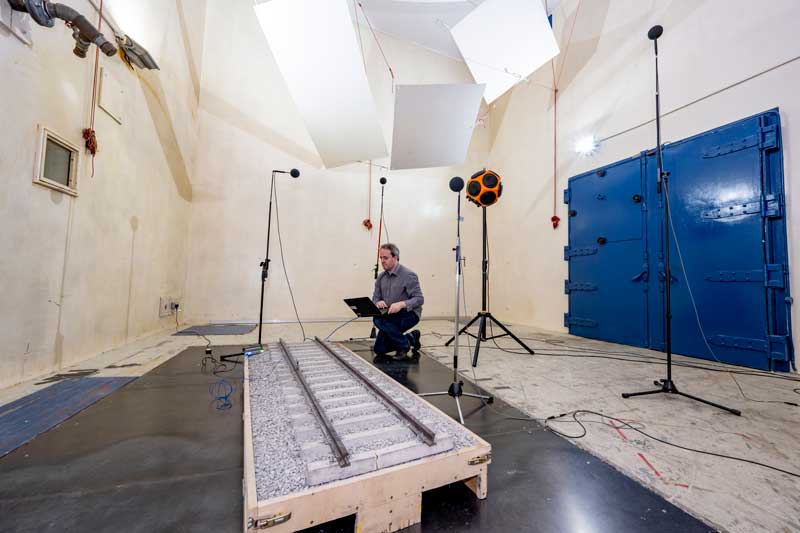The Reverberation Chambers and Transmission Suite

The Large Reverberation Chamber at ISVR Consulting
A reverberation chamber has hard surfaces which reflect sound. The sound from a machine or other noise source is reflected many times to produce a non-directional or ‘diffuse’ sound field within the chamber. The sound power emitted from a machine can then be determined from the sound level in the chamber and from the characteristics of the room such as its volume, surface area and reverberation time. Unlike the sound pressure level produced by a machine or piece of equipment, the sound power level is a property of the machine and is independent of the test environment.
A reverberation chamber is used to measure the sound absorption of acoustic materials, wall panels or screens, acoustic tiles, hanging baffles and items of furniture such as theatre seats or office desks and chairs.
A reverberation chamber enables us to generate high-intensity diffuse noise fields for acoustic fatigue testing of, for example, spacecraft and aircraft components. These components must be able to withstand high levels of noise without noise-induced vibration causing wiring or circuit boards to fail.
The Reverberation Chambers and the adjacent Anechoic Chamber are part of the University’s Rayleigh Laboratories operated by ISVR Consulting.
Technical specification
Large Reverberation Chamber
Construction
Built as a concrete box it is isolated from the adjacent anechoic and small reverberant chamber with an air gap all round. It is also isolated from the surrounding building structure with isolation joints, and the whole box stands on anti-vibration mounts to prevent structure-borne noise transmission. The walls and floor are 305 mm thick reinforced concrete and the ceiling is 460 mm thick. The internal surfaces are finished with a hard gloss paint to give a high sound reflection coefficient.
Dimensions
Built with non-parallel walls and an inclined ceiling with mean edge dimensions of 9.15 m × 6.25 m × 6.10 m high.
Volume is 348 cubic metres. Surface area is 302 square metres.
The non-parallel walls and sloping ceiling prevent ‘flutter echoes’ and standing waves, and together with painted plywood sheets suspended at random angles throughout the chamber, give a uniform diffuse field within the chamber,
Access
Heavy double doors 1.98 m wide × 2.42 m high.
There is also a 2.02 m × 2.42 m interconnecting doorway / test aperture between the Large and Small Reverberation Chambers.
Electropneumatic sound source and horn
An electropneumatic sound source, driven by compressed air, enables noise levels up to 145 dB to be generated for high-intensity noise tests.
Control room
There is a control room serving the two Reverberation Chambers and the Large Anechoic Chamber with cable ports giving access to the chambers, and a small double-glazed observation window between the control room and each of the chambers.
Small Reverberation Chamber
Construction
This chamber is of similar construction to the Large Reverberation Chamber.
Dimensions
Built with non-parallel walls and an inclined ceiling with mean edge dimensions of 6.40 m × 4.60 m × 4.30 m high.
Volume 131 cubic metres. Surface Area 153 square metres.
The non-parallel walls and sloping ceiling prevent ‘flutter echoes’ and standing waves, to give a uniform diffuse field within the chamber.
Sound sources
The electropneumatic sound source can be used to generate noise levels up to 160 dB. For lower sound levels, specialist heavy-duty mid- and high-range loudspeakers and subwoofers are used.
Transmission Suite
The Large and the Small Reverberation Chambers may be used together as a transmission suite to measure transmission losses (noise reduction) of walls, partitions, panels or double- or triple-glazing samples up to 2.0 m × 2.4 m. The wall or other test structure is built within the aperture between the Large and the Small Reverberation Chambers. Noise is then generated and measured in one chamber, and the noise transmitted though the test sample is measured in the other chamber. The drop in sound levels across the test sample enables the transmission loss to be measured in different frequency bands. Similarly, the Large Anechoic and Small Reverberant Chambers may be used where diffuse to free-field (or vice versa) testing is required.
Research and consultancy
The Reverberation Chambers are well used, not only for University research projects, but also for commercial testing and consultancy.
Typical uses include the measurement of sound power to British, European and International standards, measurements of insertion losses of hearing protectors or flight helmets using MIRE (microphone in real ear) or ATF (acoustic test fixture) methods, high‑intensity testing of satellite or aircraft components, and measurements of the sound absorption of acoustic tiles, wall coverings or theatre seats, The two chambers are used together for measuring the transmission losses of walls, partitions or glazing.
A list of the standards we test to is available on our web site.
Contact us
ISVR Consulting is an Enterprise Unit linked to the Institute of Sound and Vibration Research at the University of Southampton. We work with a wide range of industrial and commercial clients, public bodies, and government agencies in the UK and Europe. ISVR Consulting carries out tests on behalf of clients and has a wide range of specialist acoustical instrumentation and audio test equipment available. Our staff normally conduct the tests, but you can also hire the chambers to carry out your own testing with your own instrumentation, with our expertise on hand should you need it.
ISVR Consulting has produced a downloadable guide to test facilities in pdf format. This gives additional information, with photographs, on cable ports, electrical supplies, workshop facilities, air supplies, access and dimensions, etc. The guide is intended to assist clients wishing to test large pieces of equipment.
Get in touch to find out more about our facilities and how we might be able to work with you.
Tel: +44 (0) 2380 592162 email: consultancy@isvr.co.uk web: https://isvr.co.uk
Address: ISVR Consulting, Building 15 (M27), University of Southampton, University Road, Southampton, SO17 1BJ.
Location: https://what3words.com/focus.shovels.affair
There are detailed directions to our location on our ‘Contact Us‘ page.

